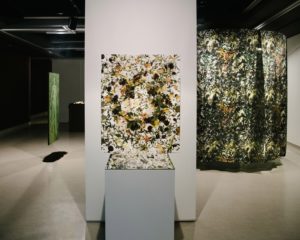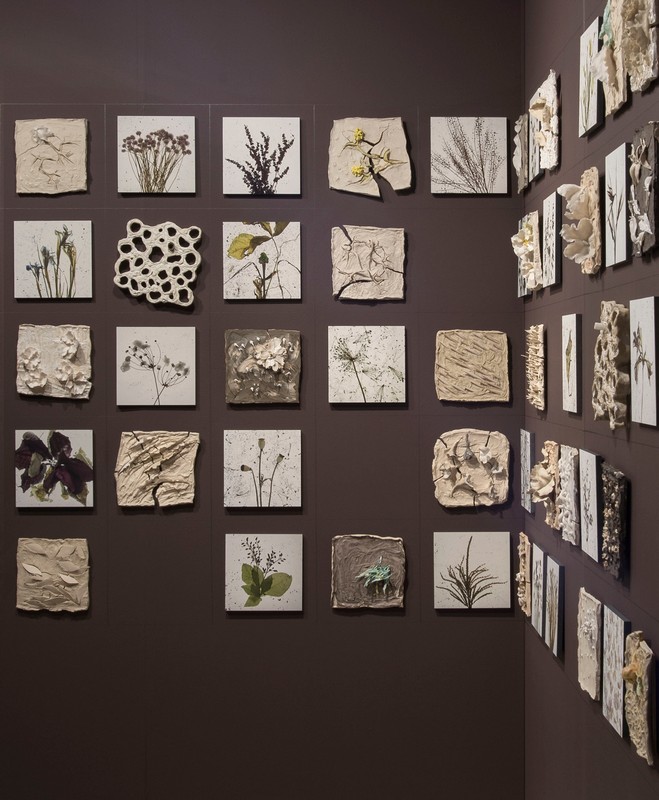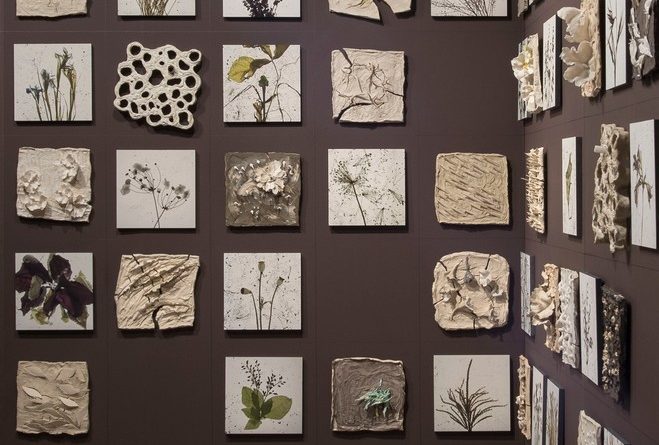Barbara Brown and Cynthia O’Brien – LifeCycle Conversations
Barbara Brown and Cynthia O’Brien – LifeCycle Conversations
Curated by Judith Parker.
Maureen Korp

Photo: City of Ottawa
A warning sign stands in the Karsh-Masson Gallery entry into “LifeCycle Conversations.” Visitors are cautioned: “This installation is delicate. Please do not touch.” Slip around the sign, carefully.
Memory, grief, and the long views of life we call “wisdom;” are the materials of the exhibition by artists Barbara Brown and Cynthia O’Brien. Their medium is sculpture and photography.
Entering the gallery, the visitor encounters “Unending (diptych),” a small sculpture atop a white plinth. The work is a wreath of porcelain flower petals and seed pods. Above the wreath, a floral montage spirals into centre. The imagery used throughout “LifeCycle Conversations” is that of seasonal plants in a temperate land.
Displayed on a nearby wall are two well-matched interpolations of thought and deed to be seen as one work. A large drawing brushed over with swaths of clay, is entitled “Earth Memories.” Its grey colorations and textures suggest an immense moth, half-seen, its wings opened wide. Upon this drawing, from time to time, “Returning,” a motion-activated video of three and a half minutes is projected. It is a tale of a woman walking away from us down a narrow path. She gets smaller and smaller, and is soon lost from sight. The path is too narrow for someone to walk with her. The forest disappears. Grey moth returns.
On the other side of the gallery, eight free-hanging panels of fine silk design hang in a spiral formation. Go ahead, walk inside. In the centre of “Whispering Garden,” stands a tall vegetal column. Tangles of leaves and branches are densely printed upon the curtains. Drift away. If one could lie down on the floor here, this would be your forested canopy.
Nearby, on top of another white plinth stands a large ceramic platter. Its colours are also those of an old forest floor. Mouldering leaves prompt new growth. Black and white spiky twigs lift the platter above a glass base. Entitled “So Below as Above,” the sculpture, like others in this exhibition, asks us to consider time, mortality, and our place in the whole of it.
Western lives are often drawn as straight lines, years to be tabulated from birth to death. Other times and places, however, have viewed individual mortality more as a spiralling line, one attuned to the rhythms of the seasons, the cycles of nature.
There are 10 sculptures in the exhibition. The largest and most complex will be found behind the standing wall at the back of the gallery. Here are 73 small plaques, each a memento mori, the whole entitled “Columbarium: A Consequence of Life.” In this work, the artists invite the public to “place a personal memorial note in one of the niches.” A columbarium is a funerary storeroom, a building with niches for the display of funerary urns.
Judith Parker, curatorial collaborator of the exhibition, notes in the curatorial essay the importance of the artists’ own background for the work of their exhibition. Barbara Brown and Cynthia O’Brien, writes Parker, have been, “…working as artists in a long-term care residence, where they befriend individuals who are near the end of their lives… .” “LifeCycle Conversations” honours what they have learned.
The artwork is fragile, do not touch. But take time to remember.
Karsh-Masson Gallery
110 Laurier Ave. W
November 8, 2018—January 9, 2019

Photo David Barbour
